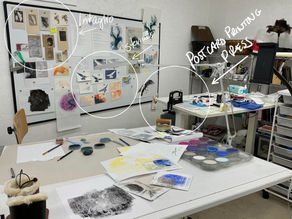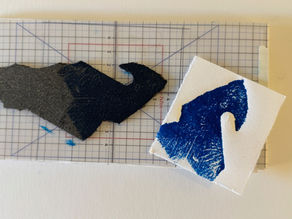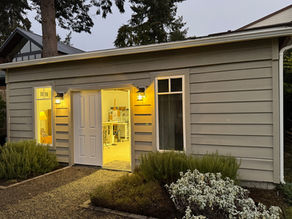The Power of Abstraction
- Caroline Clarke

- Apr 25, 2024
- 3 min read
Updated: Nov 1, 2024

In London for an art workshop last week,* our small group of six dove into exploration — with materials and process. We embraced new and different ideas, ways of working and tools. One full day we were outside at Kings Cross — drawing environments, details, people (and other things that move). Urban nature. Simplifying and abstracting. Back in the studio, I worked on the floor for the first time and gave drawing large a shot. New marks entered my vocabulary.
I had brought my pan pastels with me from home. My aim was to create a few more approaches for making pictures with them — still using crows as my subject per last week’s post.
What I found — what dawned on me slowly over the course of the week — was the power of abstraction. Abstraction as the foundation for making sense of things and for design. Abstraction for communicating concepts and telling a story. Abstraction even for expressive, realistic rendering using line, shape, value, color, space, edge and texture. Abstraction as integral for my process to make pictures.
Below: a smattering of ahas!
Abstraction to reduce overwhelm.

Drawing on location can be overwhelming — look around you, so many possibilities for things to draw! So I start by recording abstract shapes and patterns that feature in the environment.
Make squares and fill them in. Quickly — with blocks of basic shapes, values, color. Close up, far away, and in between. Vary the points of view. Extreme close-up for pattern. Choose elements from different areas and put them down. Mix and match them. Bring an element from one view into another’s square. The urban structure here is geometric, there more organic. On the page, what dominates? What could I do more of? Today I used charcoal, next time I’ll use three colors.

Bingo! — abstraction. Gets me simplifying, making choices, composing. Thumbnails. I can continue with this approach all day if I feel like it. There is no pressure to move on to detail, which suits me if/when I do go on to render one of these squares in the studio.
Make abstraction inevitable.
I want my drawings to be loose, suggestive and evocative. I want a processes that make this possible. Abstraction helps a great deal here.
The set-up — introduces from the start a bit of purposeful chaos. First, make random, abstract marks on pages, 4 minimum. Use tools that are unpredictable. This week I used twigs, scrunched up gauze, a brayer, a brush. I scratched, flicked and mono-printed. Then with each page in turn take a hard look, mull, and think about your subject matter. Crows for me. Some marks suggested backgrounds, like a forest, and others the bird itself.





Next time, I’ll make abstract marks with a crow feather. And go the other way — geometric marks made with something hard, decidedly not crow-like. I’ll think about elements in a crow’s environment and abstract for those.
Use abstraction to sneak up on rendering.
Once underway, the next trick is getting to finish — that is, to marry abstraction with intention.
The guiding principle: Take it all the way back to abstract, then find the level of detail. In a session, work on multiple “canvasses,” four minimum. Sneak up on rendering by building up the picture layer by layer. This is how many, many, many people make pictures of course. And yet we each have our own version, with subject matter, tools, approaches, design and how we abstract and render.


A closer look:

Is this experiment, thumbnail composition or finished piece?
It began with experimenting with mark making — pressing carpet remnants into ink and onto the paper, as well as brayer inked up unevenly, and the swishing of ink with a twig.
Put this together with a visit to Granary Square, Kings Cross, in London and my subjects of crows — flying here — I could call this done! More likely, I’ll call it a start.

* Art Workshop with Laura McKendry, (https://lauramckendry.com ). Special thanks to Laura for her ideas, demonstrations and guidance — they connected.

























Comments